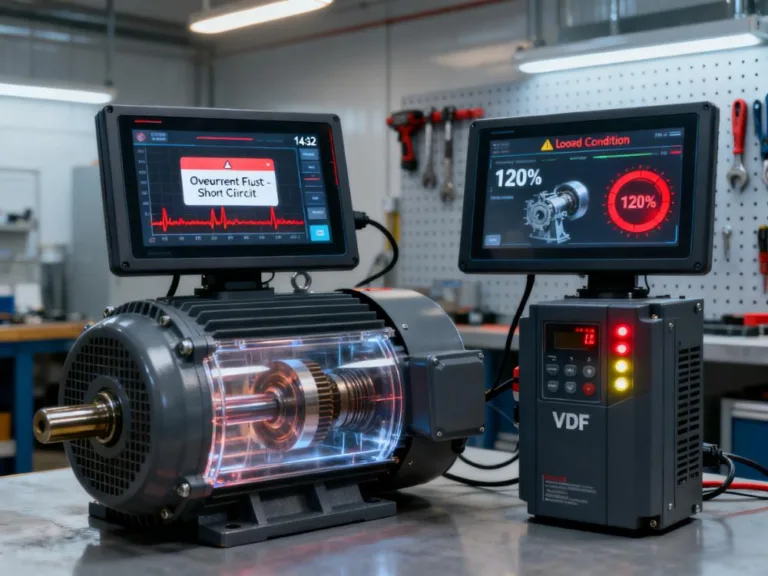3 Key Differences: VFD Overcurrent vs VFD Overload
Hello everyone, today we’ll discuss the difference between VFD overcurrent (variable frequency drive overcurrent fault) and VFD overload (variable frequency drive overload fault). These issues are very common in variable frequency drive applications and troubleshooting. Understanding their distinctions is crucial for VFD fault identification, VFD fault troubleshooting, and improving on-site maintenance efficiency. Below, we’ll elaborate from three aspects.

Different Definitions and Triggering Conditions
1.VFD Overcurrent
Definition: VFD overcurrent occurs when the drive’s output current exceeds the maximum current allowed by its hardware. This is an instantaneous protection trigger. The threshold is typically 150% to 200% of the drive’s or motor’s rated current.
Triggering Conditions:
- Short-Circuit Faults:Phase-to-phase short circuits, phase-to-ground short circuits, or cable faults in the motor can cause VFD tripping on short circuit.
- Load Impacts:Sudden bearing seizure in the motor or reducer, or VFD acceleration trip (triggered by excessively short acceleration time settings, e.g., 0.1s–0.5s) can trigger overcurrent.
- IGBT Protection Issues: IGBT breakdown or driver circuit malfunction (IGBT fails to turn off after activation) directly causes VFD overcurrent faults.
- Incorrect parameter settings: For example, using a 55kW VFD but incorrectly setting motor parameters to 7.5kW causes the VFD to apply protection thresholds for a smaller motor, instantly triggering overcurrent.
2.VFD overload
Definition: VFD overload occurs when the current sustained by the inverter or motor exceeds 105% to 150% of the rated current. Unlike transient overcurrent, it is triggered by cumulative duration.
Triggering Conditions:
- Excessive mechanical load: Such as excessive material buildup on a conveyor belt or debris clogging a pump, causing sustained current above the rated value and triggering the VFD overload fault time delay.
- Inadequate cooling: Fan failure or excessively high ambient temperatures can cause the VFD cooling method overload protection to fail, resulting in an overload alarm.
- Unreasonable parameter settings: If the overload protection current is set too low—for example, set to 120% or 150% when it should be higher—it can cause the VFD to frequently report an overload.
Differences in Detection Mechanisms and Protection Characteristics
1.VFD Overcurrent
- Detection Mechanism: Real-time monitoring via current sensing. Triggers within microseconds once current exceeds threshold.
- Protection Characteristics: Hardware protection with extremely rapid response. Directly locks out IGBTs to interrupt fault current.
2.VFD Overload
- Detection Mechanism: Integrates current and time. Higher current triggers faster; slightly exceeding limits may trigger after minutes or longer.
- Protection Feature: Software protection, involving continuous accumulation.
Different Typical Fault Scenarios
1.VFD Overcurrent Scenarios
- Short-Circuit Faults: Cable-to-ground or phase-to-phase short circuits, typical cases triggering instantaneous overcurrent vs sustained overload.
- Excessively short acceleration time: An acceleration time set for 10 seconds is reduced to 3 seconds or less, potentially causing motor locked rotor and triggering overcurrent.
- Capacitive load: When the VFD output is connected to a capacitor, a surge current occurs during startup, causing IGBT protection to activate or even break down.
2.VFD overload scenarios
- Excessive mechanical load: Accumulated dust on fan blades causes the motor to operate in a prolonged VFD overload state.
- Poor environmental cooling: Indoor temperatures exceeding 50°C trigger overload alarms in inverter fault codes.
- Incorrect sizing: Using a 7.5kW VFD to drive an 11kW motor results in sustained current exceeding the rated value, triggering overload.
Conclusion
The above comparison reveals:
VFD overcurrent is a hardware-triggered instantaneous protection, typically acting within microseconds, often caused by short circuits or transient surges.
VFD overload is a software-triggered delayed protection, operating in a current-time integration mode, commonly seen in prolonged overload or poor heat dissipation scenarios.
Understanding the difference between VFD overcurrent and overload is critical for VFD fault troubleshooting and VFD application guidance. In practical applications, proper parameter settings, correct selection, and regular maintenance can effectively prevent equipment downtime caused by VFD trip causes.
